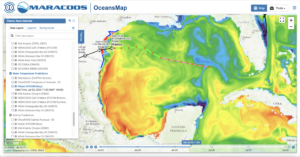-
Ocean conditions for Marco and Laura
Posted on August 23rd, 2020 No commentsBoth Marco and Laura are forecast to intensify as they cross the Gulf and approach the coast of Louisiana. Lets check the ocean conditions they are encountering (Marco) or will encounter (Laura).
First we look at Sea Surface Temperature (SST) from the data assimilative Navy GOFS model. Here the temperature scale ranges from 25C to 32C. Marco is already over the Loop Current and Laura will pass over it. Both storms will be crossing over some of the warmest sea surface temperatures in the northern Gulf off the coast of Louisiana. A good contrast in what Marco will do to the deep warm waters of the Loop Current compared to the shallow warm waters of the northern Gulf before Laura passes over them.
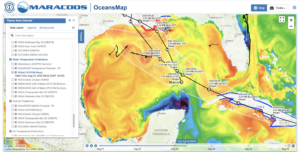
Below is the Sea Surface Salinity (SSS) map for the Gulf, with the color scale going from 34 to 37. The low surface salinity waters of the Mississippi River are evident on the Texas, Louisiana, Mississippi, Florida shelf. Our experience in the Caribbean during Isaias reminds us that the low salinity barrier layers inhibit mixing, resulting in less cooling of the surface waters, and greater potential to intensify the hurricanes.
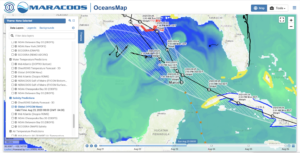
Another natural experiment on the coupled ocean-atmosphere response to 2 hurricanes will unfold over the next few days. In our textbooks, we are told that the first hurricane is supposed to mix and cool the waters so the second hurricane has less warm water to promote intensification. But the warm water in the south is the deep Loop Current that does not cool rapidly. And the warm water is blanketed by a low salinity barrier layer that inhibits mixing. The storms will be passing by Navy Glider NG645 which has been on station this season as part of the annual Hurricane Glider Picket Line. Again, much more to learn if we form the research teams to look.
-
Laura – another science storm for 2020
Posted on August 23rd, 2020 No commentsThis morning’s NHC forecast calls for Laura to continue tracking from Hispaniola along the spine of Cuba, enter the warm 31C waters of the Gulf and intensify as it moves across the Gulf towards landfall in Louisiana. With the new HWRF v13.0.0 moved to operational status on Aug 5 at 12Z, the focus of our discussions changes. All operational and many experimental models are now using the same ocean, the high quality representation derived from the Navy’s data assimilative GOFS, which is used to initialize the NOAA global RTOFS that layers in the NOAA global winds, which is then used to initialize the ocean models coupled to HWRF, HMON, and FV3 (in HAFS v0.1.a). Lets begin by looking at how this high quality ocean forecast may be influencing the hurricane forecasts.
Yesterday was a remarkable day for Laura hurricane forecasts. We noted there were significant differences in track between the 3 models (HWRF, HMON, and HAFS (v0.1.a)), and that there were significant differences in the resulting intensity as Laura entered the warm Gulf. HWRF took a more easterly track that resulted a rapid intensification to Cat4, HMON and HAFS tracked more towards Texas and was forecast to stay near or below Cat1. But how much of the difference in intensity forecast is due to the different atmospheric models, and how much is due to the different atmospheric and ocean conditions encountered along the different tracks. It is hard to separate the two. You either want the same model along two different tracks to look at the influence of track differences, or different models along the same track to look at model differences.
That makes today’s forecasts for Laura an even more remarkable day for hurricane science. Below are the forecast model results from the NOAA NWS HWRF website. Here on the left we see the HWRF (purple) and HMON (green) forecasts follow almost the exact same track into Louisiana until just before landfall. On the upper right, we see the intensity forecasts. Both HWRF (purple) and HMON (green) are predicting the rapid intensification event at the exact same time, 72 hours into the forecast. Both have it rapidly intensifying to Cat 4. Different models, same track, same ocean, same intensity forecast.

Now lets check in on one of the experimental models in HAFS, specifically version 0.1.a that is coupled to the same ocean as HWRF and HMON. Below on the left, HAFS in light blue is also crossing the Gulf on essentially the same route as HWRF and HMON, also landfalling in Louisiana, but a bit west of the others. But HAFS keeps Laura below hurricane strength the entire time.

This example illustrates the challenges of hurricane forecasting. We are 4 days before the forecast landfall in Louisiana, and with Laura, we see the models converging on a similar solution for track, but still diverging on the solution for intensity. We see that for Laura, the different HWRF and HMON models, now using the same ocean since Aug 5, converge to the same intensity forecast once the track converges. This was not the case as recently as Isaias, the storm just before Aug 5 when HMON used the high quality ocean derived from the Navy’s data assimilative GOFS, and HWRF was still using climatology.
We are learning much from this hurricane season. We are seeing improvements along the entire value chain, from the observing systems we deploy, to our ability to assimilate the data, and on to the coupled atmosphere-ocean models used for the hurricane models. And we are seeing what the NWS annual reviews have been saying for years, that we continue to make progress on track forecasts, but that improvements to intensity forecasts lag. We desperately need the research to figure out why. We have a vast pool of researchers at NOAA, the Navy, in universities and in industry that are willing to contribute, and we have the regional expertise already assembled and coordinated through U.S. IOOS and the OAR Cooperative Institutes. It is time to expand the Hurricane Forecast Improvement Program (HFIP) across agencies, across sectors, and across disciplines. If the answer is HFIP is already doing this, my question will be the same as it has been since Sandy, are we doing enough?
-
Laura and the Loop
Posted on August 22nd, 2020 No commentsThe NHC forecast discussion from this morning nicely summaries the expectations for Tropical Storm Laura as at moves into the Gulf of Mexico over the weekend. The intensity forecast approaching the Gulf is highly track dependent. If the track is mostly Hispaniola and Cuba, the rugged terrain favors keeping the intensity low. If the track is more over the water, the warm ocean favors an earlier increase in intensity. The larger intensity uncertainty occurs when Laura enters the Gulf.
For the operational models in the Gulf, HWRF track is more to the east, landfalling in MS and has a significant intensity increase to Cat 4 crossing the Gulf. HMON has a track more to the west and keeps the intensity relatively steady below Cat 1 until approaching landfall in TX. The new experimental HAFS model favors a track similar to HMON but with an intensity that never increases beyond tropical storm.
https://www.emc.ncep.noaa.gov/gc_wmb/vxt/HMON/tcall.php
It has been a season for science storms. What this storm does after it enters the Gulf will be a test case for future model improvements. Part of those studies will be to better understand the impact of the ocean on intensity. As Laura enters the Gulf, it will be crossing the Gulf’s most significant Essential Ocean Feature for hurricane intensity, the Loop Current. We start with a look at the Loop Current state in the two data assimilative global ocean models, the Navy GOFS and European Copernicus. Maps of Sea Surface Height (SSH) are plotted below from both models.
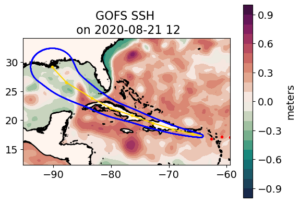
In the figure above and below, the Loop Current is high (red) sea surface height area that enters the Gulf between Yucatan and Cuba and then leaves the Gulf between Florida and Cuba. Comparing the two models we see the Loop Current position is very similar, with some slight variations in the east-west width. The models also agree that there is warm eddy north of the Loop Current and just south of Mississippi that will likely play a role in the intensity forecasts. We see the eastern path of Laura towards MS is near this warm water feature, while the western path towards TX is over more cold water (low SSH in green) features until you approach the coast of TX, when HMON says the storm could intensify.
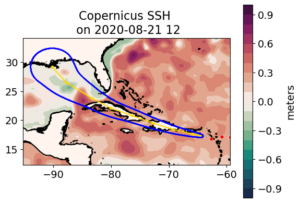
In one more plot, that warm eddy we looked at during Cristobal that was along 90W. It is now in the western Gulf centered around 94W. It is shown in the GOFS SSH plot below and is to the west of the forecast track cone for Marco.
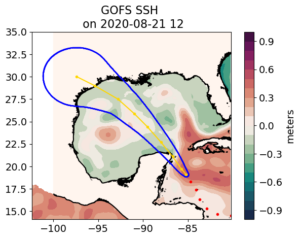
Looks like the focal points for the oceanographers for these storms will be the details of the Loop Current shape and the warm eddy south of Mississippi.
-
Two storms approach the Gulf
Posted on August 21st, 2020 No commentsTwo tropical storms are approaching the Gulf of Mexico. Tropical Storm Laura is currently over the Caribbean’s Windward Islands and is forecast to travel along the Greater Antilles along the cooler northern side of the Islands and into the very warm Sea Surface Temperatures (SST) of the Gulf were it is expected to intensify into a hurricane. Fourteen is moving northward over the warm waters of the western Caribbean towards Yucatan, then into the very warm Gulf where it is expected to intensify to a hurricane. By Tuesday next week we could have 2 hurricanes intensifying in the Gulf and about to be making landfall along the northern Gulf Coast. The very warm ocean features of the Gulf will be something to watch over the next few days. Here we are looking at the general ocean features in the Navy’s data assimilative Global Ocean Forecast System (GOFS), the start of the value chain for 3 US coupled hurricane forecast models, the operational HWRF and HMON as well as the experimental HAFS with the new FV3 core. The temperature range of the SST color bar is 25C to 31C.
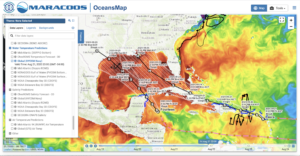
In parallel, we also watch for the low salinity barrier layers due to freshwater inputs from rivers. They are viewed below in the Sea Surface Salinity (SSS) fields also derived from the data assimilative GOFS. We see the fresh water barrier layers in the eastern Caribbean due to the Amazon and Orinoco, and the fresh water spread along the northern Gulf from the Mississippi. Here the color bar range is for salinities from 34 to 37.

So two storms entering the Gulf this weekend, both expected to intensify into hurricanes over the Gulf’s warm water early in the week, and both will be passing over the Mississippi’s freshwater barrier layers
-
A milestone week for distributed autonomy
Posted on August 14th, 2020 No commentsJust a quick shot of Kyle off the Mid Atlantic from OceansMap. Kyle is forecast to hit the warm water in the many Gulf Stream meander crests as it travels northeast. Below that is a view of Josephine as it skirts the edge of the warm water on its path just east of the Caribbean’s Windward Islands toward our friends in Bermuda operating the BIOS gliders. Two tropical storms, but the significance for us will be looking at how the new version of HWRF performs in each.
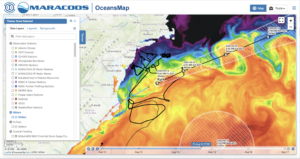
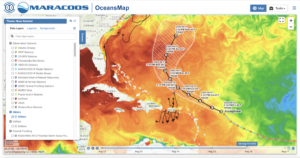
Isaias was a grand success with hurricane gliders deployed along its entire track through the IOOS regions CARICOOS, SECOORA and MARACOOS.
A science storm. Strong enough to get our attention and motivating even broader collaborations with scientists from the Argo float, underwater Glider and surface drifter communities starting to coordinate their observations and science through NOAA OAR’s Ocean Observing for Extreme Events (OOEE) working group. But Isaias used the previous version of HWRF that did not benefit from the modern suite of data assimilative ocean models.
Josephine and Kyle are being forecast using the new version of HWRF, version 13.0.0, made operational by NWS on August 5 at 12Z. We have already seen some excellent new HWRF features like improved bathymetry and an initial ocean condition derived from the NOAA global RTOFS that, in turn, is derived from the data assimilative Navy GOFS model shown in the figures above. Josephine and Kyle are the first two storms where both operational hurricane models, HWRF and HMON, have an initial ocean condition that can trace its roots to a data-assimilative ocean model. For the first time we have complete end-to-end data flow from the Hurricane Glider Picket Line to both operational hurricane models. Construction of the value chain running from ocean data delivered by a distributed network of autonomous ocean gliders to inclusion in operational forecasts is now complete.
It took so many people, and a process we began in 2014, to deliver this week on the promise of distributed autonomy for hurricane forecasting. The Concept of Operations (the ConOps as we call it) for this is new. Different gliders on different missions operated by different groups funded for different purposes by different government agencies like NOAA, Navy, NSF, industry partners like Shell in the Gulf or Orsted in the Mid Atlantic, or foundations like Vetlesen in the Caribbean, all contributing their near real time quality-controlled data in standard formats through the IOOS Glider DAC so that it can be delivered via GTS to the global modeling centers for improved hurricane forecasts. We are a distributed team with so many collaborators from NOAA OAR, NOS and NWS, the Navy, IOOS and its North Atlantic hurricane-prone Regional Associations (MARACOOS, SECOORA, GCOOS and CARICOOS), industry partners (energy sector, data management, glider manufacturers, sensor manufacturers) and academics from the Caribbean to the Gulf of Mexico to the Gulf of Maine. We have dedicated time and effort to deliver the technology, the scientific justification, and the real time data streams we need to support improved forecasts for all. We have demonstrated that by engaging the many strengths of our distributed community, it can be done.
Work hard, have fun, change the world. Thank you Doug Webb for these words to live by.
Happy Friday All.
-
Preparing for Isaias with a Great Global Model
Posted on July 31st, 2020 No commentsThis morning’s MARACOOS operations meeting focused on the final preparations before the forecast passage of Hurricane Isaias. Here is a quick update on the operational models they support.
First is a 3 day composite satellite sea surface temperature map of the Mid Atlantic generated by Matt Oliver with the underwater glider tracks in black and the forecast track (black) and cone (white) of Isaias plotted on top. The color bar on the SST is adjusted to highlight temperatures from 18C to 30C. We see the warm Gulf Stream offshore with Robert Todd’s gliders in them. The cluster of NSF OOI gliders south of Cape Cod that are in that cold water that is advecting south along the shelf break, and the MARACOOS and Navy gliders on the shelf mapping the bottom cold pool that lies below the very warm shelf surface water – nearly as warm as the Gulf Stream.
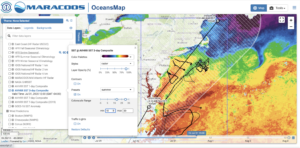
First we look at the Navy Global Ocean Forecast System (GOFS) from the top. Here we plot SST from GOFS using the same color scale as above. Se see the warm Gulf Stream Offshore. The advection of the cold surface water through the NSF OOI array. And the warm surface water over the shelf.
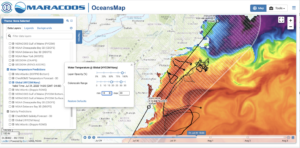
But what is happening below the surface? Is GOFS, the start of our data assimilative value chain, getting the Mid Atlantic’s Cold Pool?
Here is one of those glider data/model comparisons that Maria generates every day. Blue is the data from the glider, with light blue being all the profiles and dark blue being the average. Red is the Navy GOFS, start of the ocean component of the hurricane forecast value chain. The surface temperature is spot on. The thermocline is spot on. Bottom temperature is close. The European model is a little cooler at the top and warmer at the bottom, which reduces the slope and therefore the stratification. Getting the shelf response right is all about the stratification. Then in green is the NOAA ROTFS model, next step in the hurricane value chain where the NOAA winds are layered on. The surface temperature is right. The surface mixed layer temperature is right. The slope of the temperature change in the thermocline is right. The bottom temperature is right. And this is from a suite of global models – informed by local data.
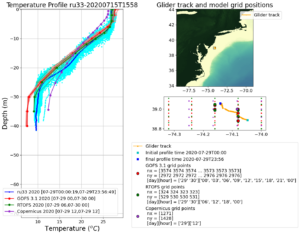
Results like this have been a long time in the making. In the Mid-Atlantic, in MARACOOS, and in our Universities with our students, we have been working this issue since the back to back impact years of Irene and Sandy. It represents the persistent efforts of our dedicated field crews that work to maintain our observation network, our modelers for ROMS and WRF, and our data managers up at RPS in Rhode Island that keep OceansMap working every day. It is the work of our many glider partners from the people that make the gliders at TWR in Massachusetts, to the people that fly them, to the people that manage the data at the US IOOS Glider DAC, the pilots at the Navy GOC, to the people at NDBC that send the data off through the GTS, and to the people that pull it out of the data tanks and into their operational models. It is the work of the Navy modelers at NRL Stennis that spent countless hours helping us track the data through the assimilation system, and the NOAA modelers at NCEP that keep RTOFS running and answer our many, many questions about the operational system, especially our good friends Hyun Sook and Zulema who work with Maria everyday. To our partners in research at AOML, and across the IOOS Regional Associations along the hurricane pathways – together we have defined the Essential Ocean Features that impact hurricane intensity in our regions, and together with IOOS, OAR, Navy, NSF, the universities, the energy industry, and the glider manufacturers, we have assembled the hurricane glider picket line that monitors those features and protects our nation’s coasts like the soccer goalie protects the goal. Literally the work of hundreds of people going into what is summarized above in 3 simple plots – the Mid Atlantic is Ready.
Bravo Zulu.
Force, wind and honor.
Work hard, have fun, change the world.
They all apply. We are getting the job done.
Happy Friday All.
-
One Ocean for Potential TS Nine
Posted on July 28th, 2020 No commentsIn terms of the ocean, we have never been more ready. Potential Tropical Storm Nine is crossing over the same ocean in all the forecast models.
Here is SST from HMON’s HYCOM. This is part of the global GOFS to global RTOFS to regional HYCOM value chain.
We see the same features we talked about in the morning blog on the global models.
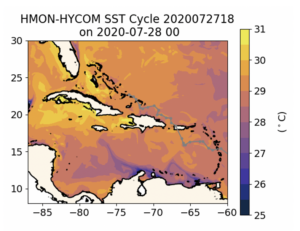
Here is the SST from HWRF that is coupled to MPIPOM. Focus on the Caribbean and along the track of the storm. The features are nearly the same. The cold water upwelled along the coast of South America is being advected around the Caribbean-wide anticyclonic feature south of Hispaniola in HMON and HWRF. The warmest water is up by Puerto Rico where AOML has the densest part of glider picket line in place well in advance. We saw in the morning blog that within that region covered by the gliders, the global models are all in really good agreement, telling us that even the different assimilation schemes appear to be bringing us closer together. The temperature ranges are so similar in these plots. All the US models are lining up in agreement on the basic Essential Ocean Features and temperature range before the storm, with the European Copernicus now representing a similarly structured but slightly warmer version of the ocean.
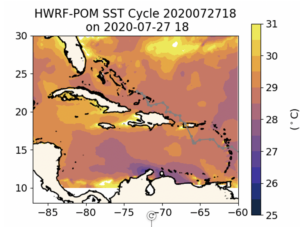
Much more to look at tonight. But from this initial look at the ocean side, we can’t be more ready.
-
Preparing for Potential TC Nine
Posted on July 28th, 2020 No commentsNHC 11 am message renamed the disturbance Potential Tropical Cyclone Nine. Prompts us to do a quick tour of the data assimilative global models, Navy GOFS and European Copernicus.
First is GOFS SST, and below it Copernicus SST. Maria has made these new plots easier to interpret. Colors are now in 0.5C increments, with the range tuned to each region. First impression is that Copernicus warmer than GOFS, often by about 0.5 C.
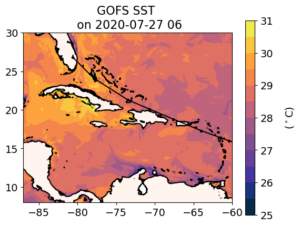

Now for the surface salinity as a proxy look at the barrier layers. Copernicus is generally fresher, possibility with more substantial barrier layers.
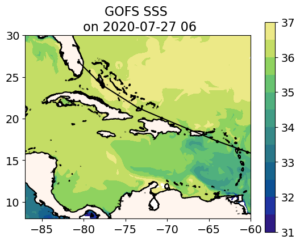
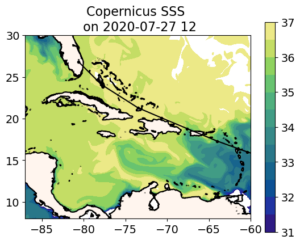
Warmer Sea Surface Temperature (SST) and lower sea surface salinity (SSS) in Copernicus mean more potential for intensification with the Copernicus ocean.
-
Preparing for Disturbance 1
Posted on July 27th, 2020 No commentsDisturbance 1 is heading toward the Lesser Antilles. Just beyond this line of islands is Puerto Rico, surrounded by the extensive AOML glider fleet. I’ll start with one quick comparison tonight. You only need to look once, the result is the same for glider after glider. The data assimilative models are doing really well.
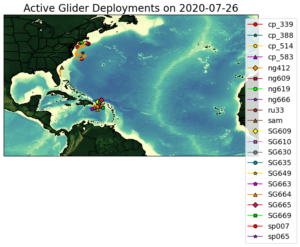
I’ll show glider SG699, the most forward glider in the array, on the southeast corner. First plot is the temperature profile. All three global models are in amazing agreement. It gives us a lot of confidence when all the models agree, that the sensitivities to the different methods of assimilation are small compared to the value added by the data.
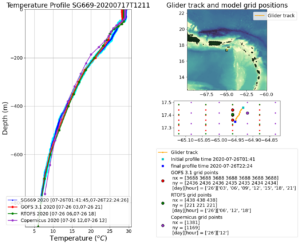
Next is salinity. Again, very good agreement through most of the water column. The important features are the subsurface peak in salinity about 180 m deep, and how the salinity then decreases as you approach the surface. The exciting thing here is that the global models all have a low salinity barrier layer. There are some differences between the model and the salinity data. The barrier layer is thinner and less salty in the data. Depth of the barrier layer looks to be more tied to the temperature profile in the model. But looking from the perspective of a global model informed by local data, this is really good.
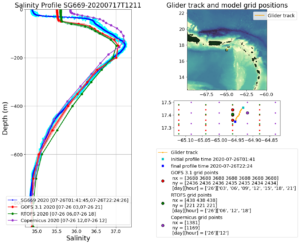
If you click on the other automated model/glider comparison plots Maria posts
https://rucool.marine.rutgers.edu/hurricane/Hurricane_season_2020/
you will see similarly good agreement between the glider data and the models for multiple gliders. Looks like all the pieces are working together, with the glider data ensuring that the global models have time to be on track well before the storm hits. This is the plan in action.
Now that we know the global models are doing a fairly good job of including the barriers layers at least where we have data to assimilate, let’s take a look at the spatial distribution of sea surface salinity from the Navy GOFS model. In the OceansMap layer below, we use a salinity color scale from blue (33) to green (36). The plume of the Amazon and Orinoco rivers make it through the passages between the Windward Islands, especially by South America, remaining relatively fresh heading northwest towards Puerto Rico. South of Hispaniola you see the Caribbean-wide mesoscale feature wrapping fresh water around itself. Looking back at Puerto Rico, you can see why glider SG699 is a bit more salty than the observations. There are some small submesoscale features in the model just South of St. Croix. Looking at the profiles above tends to push you towards invoking vertical processes to explain the differences in barrier layer salinity, but the maps tend to lean you towards small scale horizontal processes being something to consider. Also remember, these are global ocean models, the smaller scale horizontal processes are supposed to be cleaned up by the higher resolution nested regional ocean models. Bottom line, from what we can see, we have the global model ocean in pretty good shape in the area near Puerto Rico well before the tropical disturbance arrives.
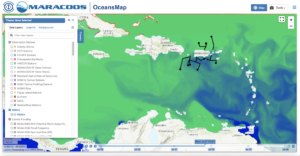
-
Saturday Morning MARACOOS OceansMap Hurricane Figure Contest Winner
Posted on July 25th, 2020 No commentsIts close enough to noon that we can declare Doug Wilson’s – from Ocean and Coastal Observing – Virgin Islands (OCO-VI) – contribution the winning hurricane figure of the morning. It is a figure produced from MARACOOS OceansMap that plots the sea surface temperature from the Navy Global Ocean Forecast System (a HYCOM based model, hence the name in OceansMap, Navy HYCOM) in the Caribbean, with the temperatures enhanced to highlight the coastal upwelling along South America. The more southerly track of Gonzalo is going right over the colder water. Another important feature of the adjustable scales is that ability to highlight specific features, like that anticyclonic eddy south of Hispaniola that is not in MPIPOM. This is an area begging for an Argo float comparison. Something we can check into next week.

To not leave Hanna out of the mix, here is a similar plot for the Gulf of Mexico. Here I adjusted the temperature scale so that it ranges from 25 to 32. Our automated plots made overnight give us the ability to quickly browse for interesting subjects. Then OceansMap enables the deep dive. Again we have a story of coastal upwelling, both in front of Hanna, and very much along the Yucatan shelf. You can see the cold upwelled Yucatan shelf water being pulled north along the Loop Current. I wonder if images like this would help the NHC forecasts that have to define the edge of the Loop Current for the MPIPOM feature model initialization. Maybe we can talk to them more about how they do that. Another interesting feature is the Anticyclonic Eddy just north of Yucatan that was featured in the TS Cristobal blogs. You can see this eddy has continued to propagate westward since Cristobal crossed directly over it along 90W. Recall that this eddy is not in the MPIPOM model for Cristobal, since it needs to be inserted through the warm eddy feature model.
